check oil NISSAN TITAN 2019 Owner´s Manual
[x] Cancel search | Manufacturer: NISSAN, Model Year: 2019, Model line: TITAN, Model: NISSAN TITAN 2019Pages: 682, PDF Size: 7.99 MB
Page 505 of 682
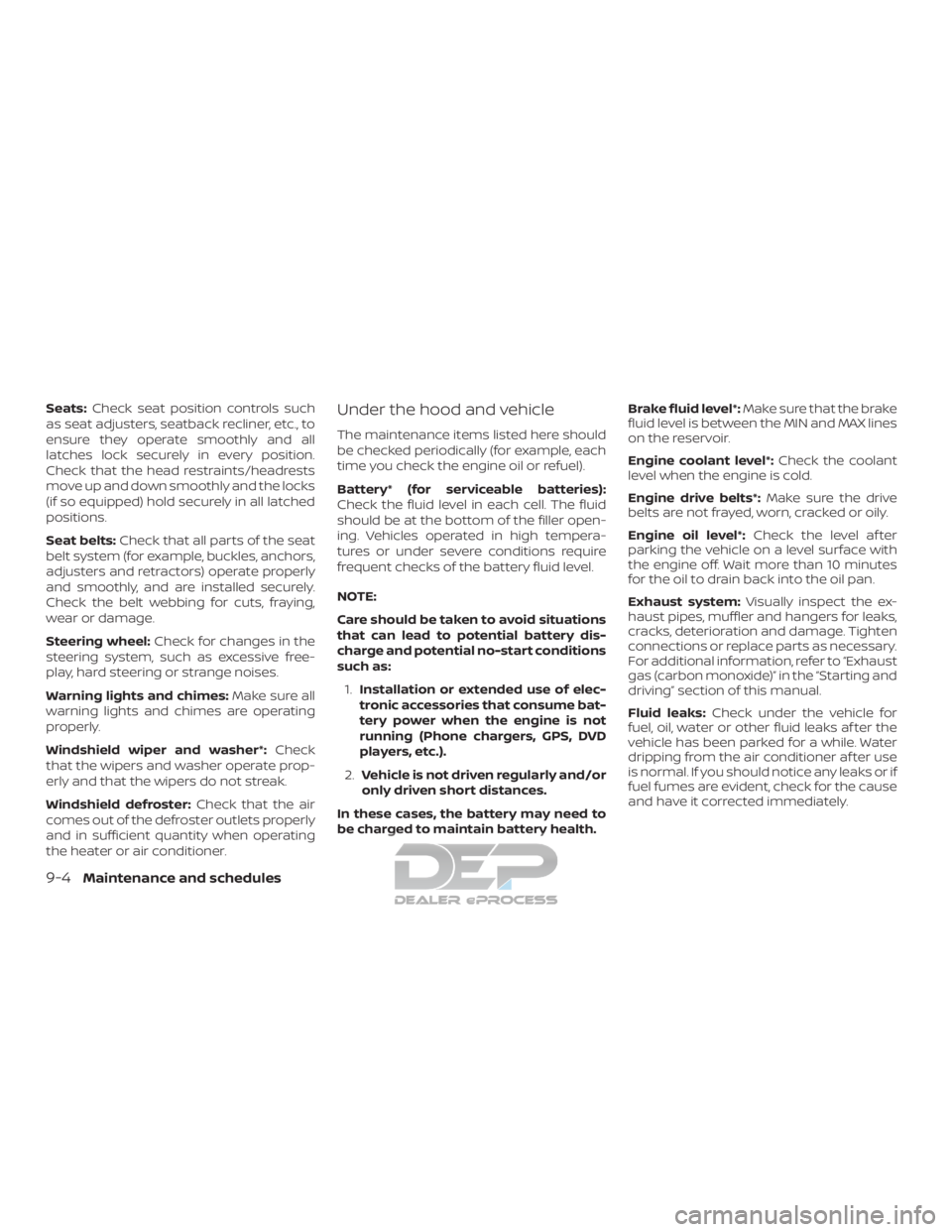
Seats:Check seat position controls such
as seat adjusters, seatback recliner, etc., to
ensure they operate smoothly and all
latches lock securely in every position.
Check that the head restraints/headrests
move up and down smoothly and the locks
(if so equipped) hold securely in all latched
positions.
Seat belts: Check that all parts of the seat
belt system (for example, buckles, anchors,
adjusters and retractors) operate properly
and smoothly, and are installed securely.
Check the belt webbing for cuts, fraying,
wear or damage.
Steering wheel: Check for changes in the
steering system, such as excessive free-
play, hard steering or strange noises.
Warning lights and chimes: Make sure all
warning lights and chimes are operating
properly.
Windshield wiper and washer*: Check
that the wipers and washer operate prop-
erly and that the wipers do not streak.
Windshield defroster: Check that the air
comes out of the defroster outlets properly
and in sufficient quantity when operating
the heater or air conditioner.Under the hood and vehicle
The maintenance items listed here should
be checked periodically (for example, each
time you check the engine oil or refuel).
Battery* (for serviceable batteries):
Check the fluid level in each cell. The fluid
should be at the bottom of the filler open-
ing. Vehicles operated in high tempera-
tures or under severe conditions require
frequent checks of the battery fluid level.
NOTE:
Care should be taken to avoid situations
that can lead to potential battery dis-
charge and potential no-start conditions
such as:
1. Installation or extended use of elec-
tronic accessories that consume bat-
tery power when the engine is not
running (Phone chargers, GPS, DVD
players, etc.).
2. Vehicle is not driven regularly and/or
only driven short distances.
In these cases, the battery may need to
be charged to maintain battery health. Brake fluid level*:
Make sure that the brake
fluid level is between the MIN and MAX lines
on the reservoir.
Engine coolant level*: Check the coolant
level when the engine is cold.
Engine drive belts*: Make sure the drive
belts are not frayed, worn, cracked or oily.
Engine oil level*: Check the level af ter
parking the vehicle on a level surface with
the engine off. Wait more than 10 minutes
for the oil to drain back into the oil pan.
Exhaust system: Visually inspect the ex-
haust pipes, muffler and hangers for leaks,
cracks, deterioration and damage. Tighten
connections or replace parts as necessary.
For additional information, refer to “Exhaust
gas (carbon monoxide)” in the “Starting and
driving” section of this manual.
Fluid leaks: Check under the vehicle for
fuel, oil, water or other fluid leaks af ter the
vehicle has been parked for a while. Water
dripping from the air conditioner af ter use
is normal. If you should notice any leaks or if
fuel fumes are evident, check for the cause
and have it corrected immediately.
9-4Maintenance and schedules
Page 507 of 682
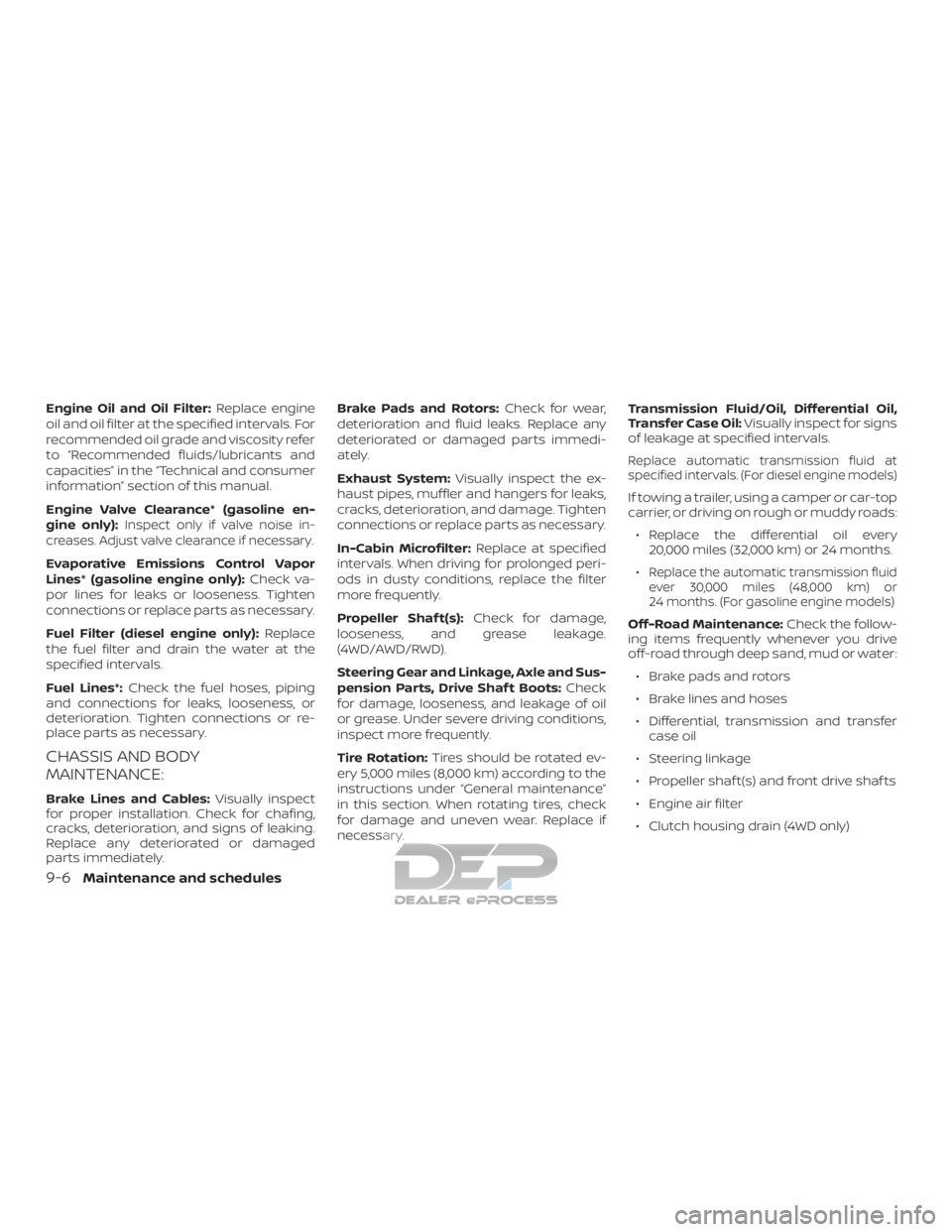
Engine Oil and Oil Filter:Replace engine
oil and oil filter at the specified intervals. For
recommended oil grade and viscosity refer
to “Recommended fluids/lubricants and
capacities” in the “Technical and consumer
information” section of this manual.
Engine Valve Clearance* (gasoline en-
gine only):
Inspect only if valve noise in-
creases. Adjust valve clearance if necessary.
Evaporative Emissions Control Vapor
Lines* (gasoline engine only): Check va-
por lines for leaks or looseness. Tighten
connections or replace parts as necessary.
Fuel Filter (diesel engine only): Replace
the fuel filter and drain the water at the
specified intervals.
Fuel Lines*: Check the fuel hoses, piping
and connections for leaks, looseness, or
deterioration. Tighten connections or re-
place parts as necessary.
CHASSIS AND BODY
MAINTENANCE:
Brake Lines and Cables: Visually inspect
for proper installation. Check for chafing,
cracks, deterioration, and signs of leaking.
Replace any deteriorated or damaged
parts immediately. Brake Pads and Rotors:
Check for wear,
deterioration and fluid leaks. Replace any
deteriorated or damaged parts immedi-
ately.
Exhaust System: Visually inspect the ex-
haust pipes, muffler and hangers for leaks,
cracks, deterioration, and damage. Tighten
connections or replace parts as necessary.
In-Cabin Microfilter: Replace at specified
intervals. When driving for prolonged peri-
ods in dusty conditions, replace the filter
more frequently.
Propeller Shaf t(s): Check for damage,
looseness, and grease leakage.
(4WD/AWD/RWD).
Steering Gear and Linkage, Axle and Sus-
pension Parts, Drive Shaf t Boots: Check
for damage, looseness, and leakage of oil
or grease. Under severe driving conditions,
inspect more frequently.
Tire Rotation: Tires should be rotated ev-
ery 5,000 miles (8,000 km) according to the
instructions under “General maintenance”
in this section. When rotating tires, check
for damage and uneven wear. Replace if
necessary. Transmission Fluid/Oil, Differential Oil,
Transfer Case Oil:
Visually inspect for signs
of leakage at specified intervals.
Replace automatic transmission fluid at
specified intervals. (For diesel engine models)
If towing a trailer, using a camper or car-top
carrier, or driving on rough or muddy roads:
∙ Replace the differential oil every 20,000 miles (32,000 km) or 24 months.
∙
Replace the automatic transmission fluid
ever 30,000 miles (48,000 km) or
24 months. (For gasoline engine models)
Off-Road Maintenance: Check the follow-
ing items frequently whenever you drive
off-road through deep sand, mud or water:
∙ Brake pads and rotors
∙ Brake lines and hoses
∙ Differential, transmission and transfer case oil
∙ Steering linkage
∙ Propeller shaf t(s) and front drive shaf ts
∙ Engine air filter
∙ Clutch housing drain (4WD only)
9-6Maintenance and schedules
Page 530 of 682

Octane rating tips
Using unleaded gasoline with an octane
rating lower than recommended can
cause persistent, heavy “spark knock.”
(“Spark knock” is a metallic rapping
noise.) If severe, this can lead to engine
damage. If you detect a persistent heavy
spark knock even when using gasoline
of the stated octane rating, or if you hear
steady spark knock while holding a
steady speed on level roads, it is recom-
mended that you have a NISSAN dealer
correct the condition. Failure to correct
the condition is misuse of the vehicle, for
which NISSAN is not responsible.
Incorrect ignition timing may result in
spark knock, af ter-run and/or overheating,
which may cause excessive fuel consump-
tion or engine damage. If any of the above
symptoms are encountered, have your ve-
hicle checked. It is recommended that you
visit a NISSAN dealer for servicing.
However, now and then you may notice
light spark knock for a short time while
accelerating or driving up hills. This is not
a cause for concern, because you get the
greatest fuel benefit when there is light
spark knock for a short time under heavy
engine load.
ENGINE OIL AND OIL FILTER
RECOMMENDATIONS (for gas
engine only)
For diesel engine oil and oil filter recom-
mendations, refer to “Engine oil and oil filter
recommendations” section of the Titan
Diesel Owner’s Manual.
Selecting the correct oil
It is essential to choose the correct grade,
quality and viscosity engine oil to ensure
satisfactory engine life and performance.
For additional information, refer to “Recom-
mended fluids/lubricants and capacities”in this section. NISSAN recommends the
use of an energy conserving oil in order to
improve fuel economy.
Select only engine oils that meet the
American Petroleum Institute (API) certifi-
cation or International Lubricant Standard-
ization and Approval Committee (ILSAC)
certification and SAE viscosity standard.
These oils have the API certification mark
on the front of the container. Oils which do
not have the specified quality label should
not be used as they could cause engine
damage.
LTI2051
Technical and consumer information10-7
Page 585 of 682
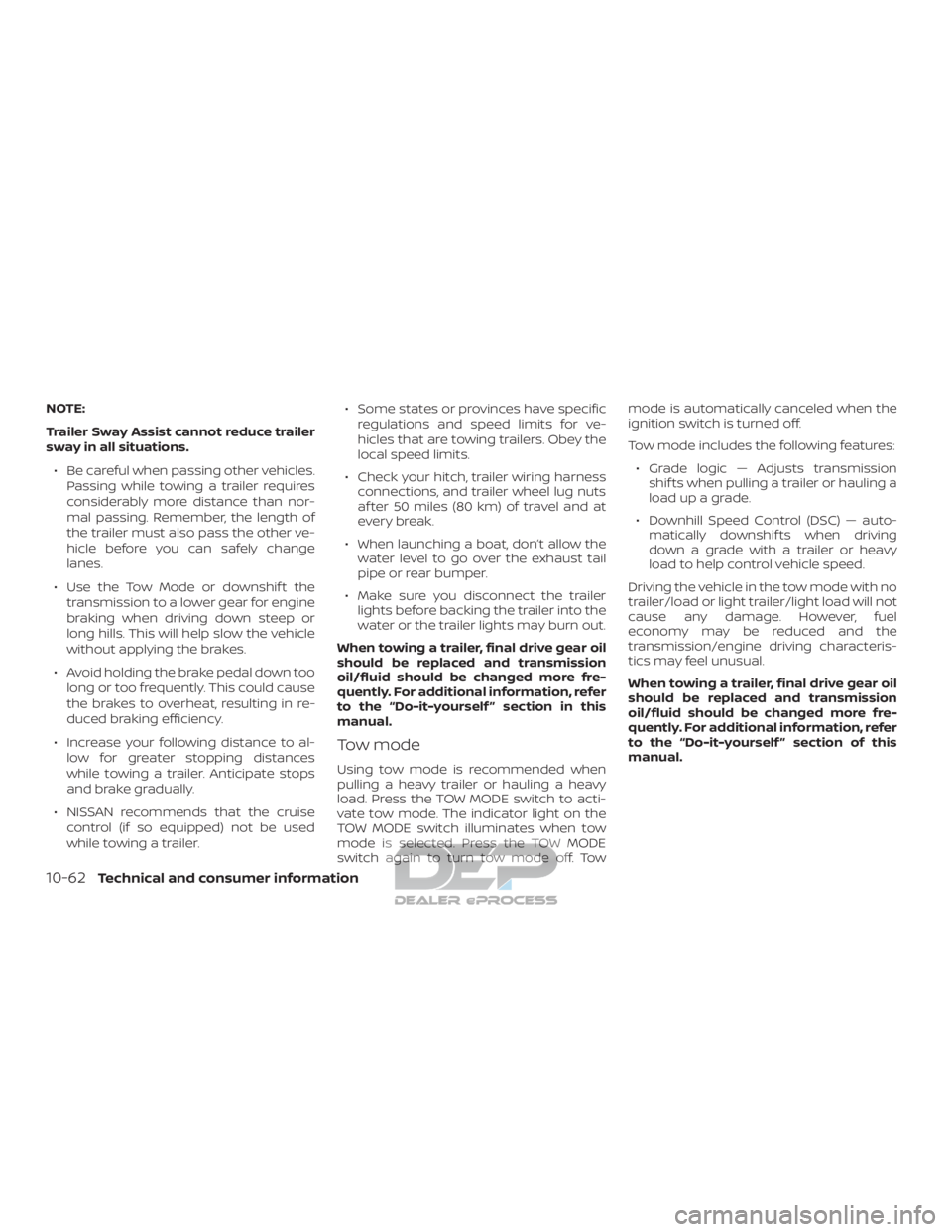
NOTE:
Trailer Sway Assist cannot reduce trailer
sway in all situations.∙ Be careful when passing other vehicles. Passing while towing a trailer requires
considerably more distance than nor-
mal passing. Remember, the length of
the trailer must also pass the other ve-
hicle before you can safely change
lanes.
∙ Use the Tow Mode or downshif t the transmission to a lower gear for engine
braking when driving down steep or
long hills. This will help slow the vehicle
without applying the brakes.
∙ Avoid holding the brake pedal down too long or too frequently. This could cause
the brakes to overheat, resulting in re-
duced braking efficiency.
∙ Increase your following distance to al- low for greater stopping distances
while towing a trailer. Anticipate stops
and brake gradually.
∙ NISSAN recommends that the cruise control (if so equipped) not be used
while towing a trailer. ∙ Some states or provinces have specific
regulations and speed limits for ve-
hicles that are towing trailers. Obey the
local speed limits.
∙ Check your hitch, trailer wiring harness connections, and trailer wheel lug nuts
af ter 50 miles (80 km) of travel and at
every break.
∙ When launching a boat, don’t allow the water level to go over the exhaust tail
pipe or rear bumper.
∙ Make sure you disconnect the trailer lights before backing the trailer into the
water or the trailer lights may burn out.
When towing a trailer, final drive gear oil
should be replaced and transmission
oil/fluid should be changed more fre-
quently. For additional information, refer
to the “Do-it-yourself ” section in this
manual.
Tow mode
Using tow mode is recommended when
pulling a heavy trailer or hauling a heavy
load. Press the TOW MODE switch to acti-
vate tow mode. The indicator light on the
TOW MODE switch illuminates when tow
mode is selected. Press the TOW MODE
switch again to turn tow mode off. Tow mode is automatically canceled when the
ignition switch is turned off.
Tow mode includes the following features:
∙ Grade logic — Adjusts transmission shif ts when pulling a trailer or hauling a
load up a grade.
∙ Downhill Speed Control (DSC) — auto- matically downshif ts when driving
down a grade with a trailer or heavy
load to help control vehicle speed.
Driving the vehicle in the tow mode with no
trailer/load or light trailer/light load will not
cause any damage. However, fuel
economy may be reduced and the
transmission/engine driving characteris-
tics may feel unusual.
When towing a trailer, final drive gear oil
should be replaced and transmission
oil/fluid should be changed more fre-
quently. For additional information, refer
to the “Do-it-yourself ” section of this
manual.
10-62Technical and consumer information
Page 592 of 682
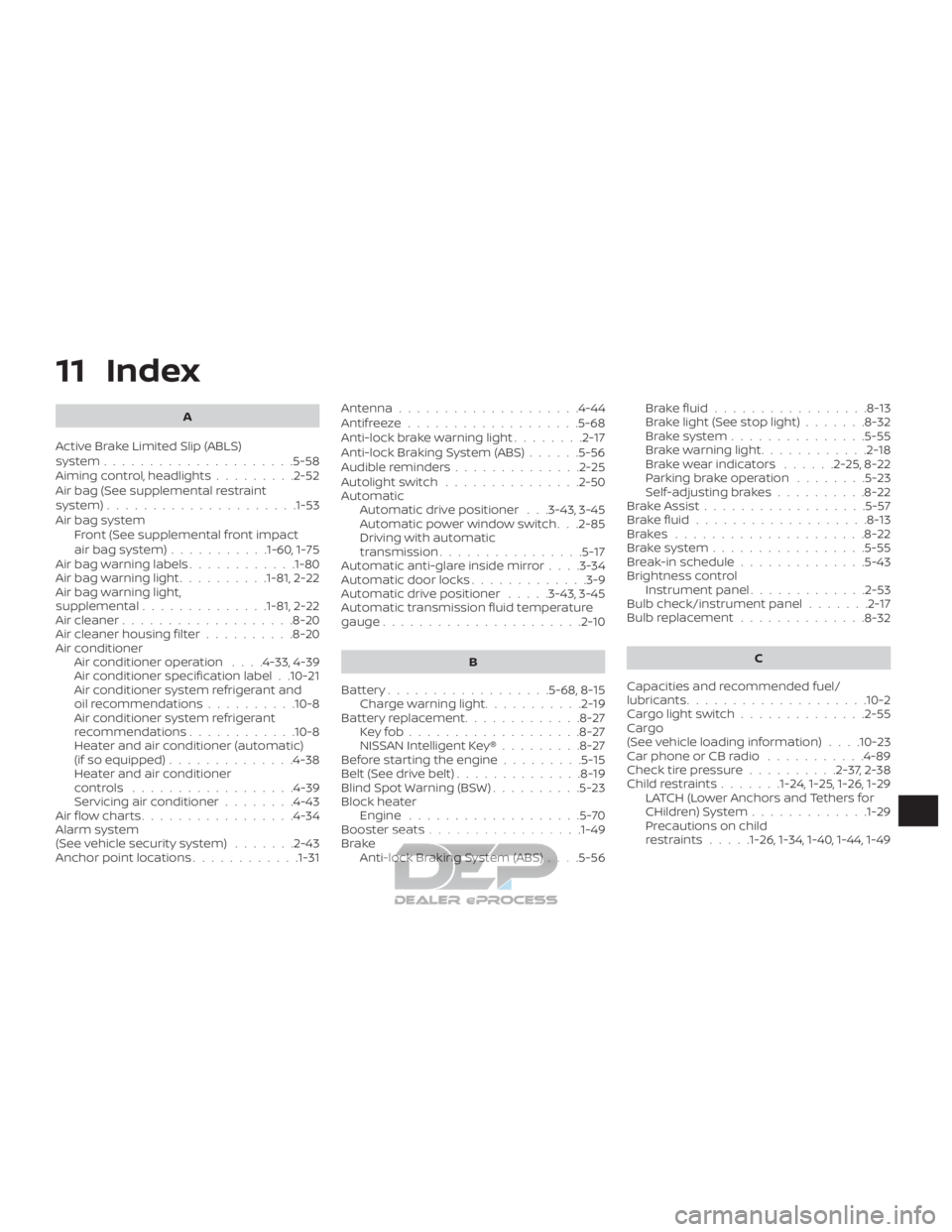
11 Index
A
Active Brake Limited Slip (ABLS)
system .....................5-58
Aimingcontrol,headlights.........2-52
Air bag (See supplemental restraint
system) .................... .1-53
Air bag system Front (See supplemental front impact
airbagsystem)...........1-60, 1-75
Air bag warning labels ............1-80
Airbagwarninglight..........1-81, 2-22
Air bag warning light,
supplemental ..............1-81, 2-22
Air cleaner ...................8-20
Air cleaner housing filter ..........8-20
Air conditioner Air conditioner operation ....4-33,4-39
Air conditioner specification label . .10-21
Air conditioner system refrigerant and
oil recommendations ..........10-8
Air conditioner system refrigerant
recommendations ............10-8
Heater and air conditioner (automatic)
(if so equipped) ..............4-38
Heater and air conditioner
controls ..................4-39
Servicing air conditioner ........4-43
Air flow charts .................4-34
Alarm system
(See vehicle security system) .......2-43
Anchor point locations ............1-31 Antenna
....................4-44
Antifreeze ...................5-68
Anti-lock brake warning light ........2-17
Anti-lock Braking System (ABS) ......5-56
Audible reminders ..............2-25
Autolightswitch ...............2-50
Automatic Automatic drive positioner . . .3-43, 3-45
Automatic power window switch . . .2-85
Driving with automatic
transmission ................5-17
Automatic anti-glare inside mirror . . . .3-34
Automatic door locks .............3-9
Automatic drive positioner .....3-43,3-45
Automatic transmission fluid temperature
gauge ......................2-10
B
Battery..................5-68,8-15 Charge warning light ...........2-19
Battery replacement .............8-27
Keyfob...................8-27
NISSAN Intelligent Key® .........8-27
Before starting the engine .........5-15
Belt(Seedrivebelt)..............8-19
Blind Spot Warning (BSW) ..........5-23
Block heater Engine ...................5-70
Booster seats .................1-49
Brake Anti-lock Braking System (ABS) ....5-56Brakefluid.................8-13
Brakelight(Seestoplight).......
8-32
Brakesystem...............5-55
Brakewarninglight............2-18
Brakewearindicators ......2-25,8-22
Parking brake operation ........5-23
Self-adjustingbrakes..........8-22
Brake Assist ..................5-57
Brakefluid...................8-13
Brakes .....................8-22
Brakesystem................ .5-55
Break-in schedule ..............5-43
Brightness control Instrument panel .............2-53
Bulb check/instrument panel .......2-17
Bulb replacement ..............
8-
32
C
Capacities and recommended fuel/
lubricants....................10-2
Cargolightswitch..............2-55
Cargo
(See vehicle loading information) ....10-23
Car phone or CB radio ...........4-89
Check tire pressure ..........2-37, 2-38
Childrestraints.......1-24, 1-25, 1-26, 1-29 LATCH (Lower Anchors and Tethers for
CHildren)System.............1-29
Precautions on child
restraints.....1-26, 1-34, 1-40, 1-44, 1-49
Page 593 of 682
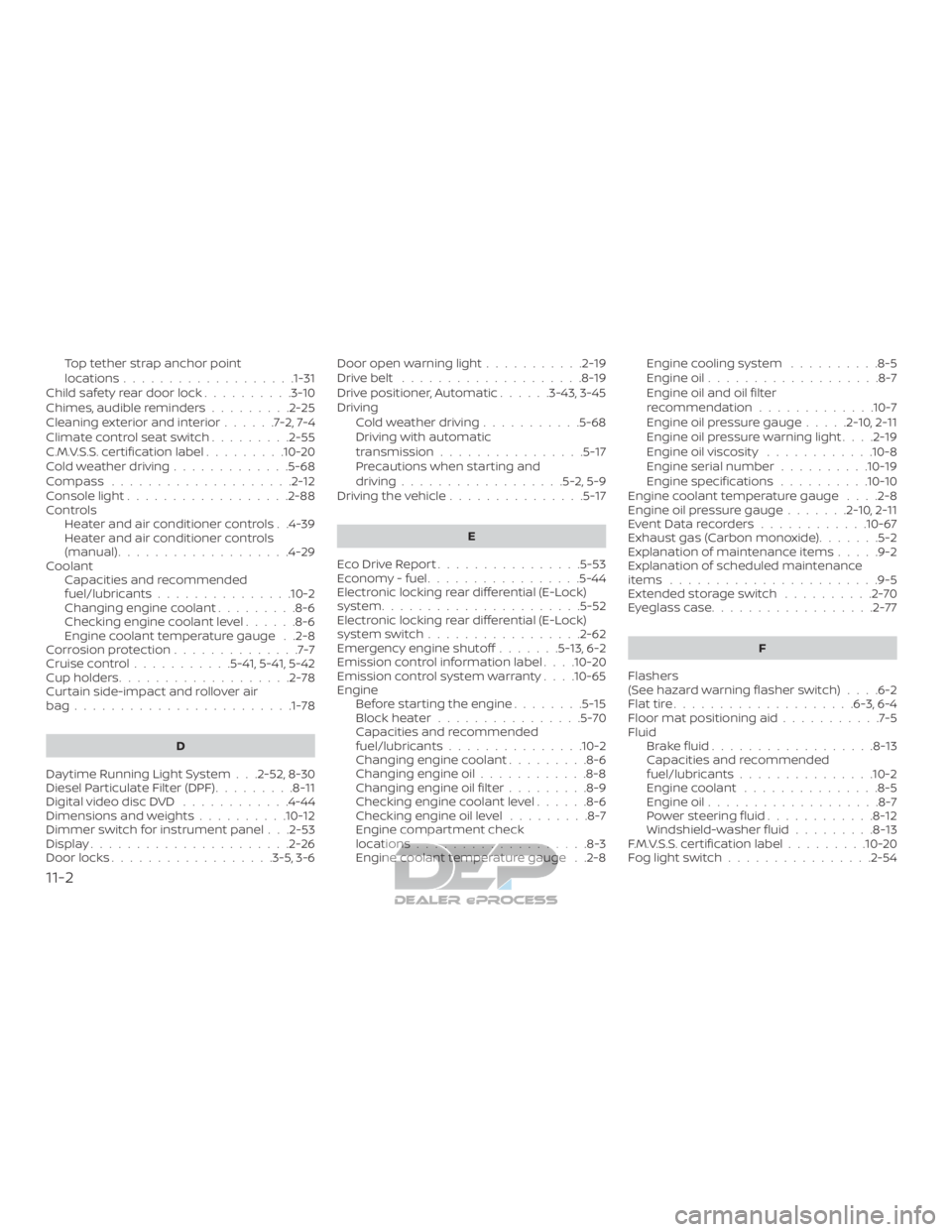
Top tether strap anchor point
locations...................1-31
Child safety rear door lock ..........3-10
Chimes, audible reminders .........2-25
Cleaningexteriorandinterior......7-2,7-4
Climatecontrolseatswitch.........2-55
C.M.V.S.S. certification label .........10-20
Coldweatherdriving.............5-68
Compass ....................2-12
Console light ..................2-88
Controls Heater and air conditioner controls . .4-39
Heater and air conditioner controls
(manual) ...................4-29
Coolant Capacities and recommended
fuel/lubricants...............10-2
Changing engine coolant .........8-6
Checking engine coolant level ......8-6
Engine coolant temperature gauge . .2-8
Corrosionprotection..............7-7
Cruisecontrol...........5-41,5-41,5-42
Cupholders...................2-78
Curtain side-impact and rollover air
bag........................1-78
D
Daytime Running Light System . . .2-52, 8-30
Diesel Particulate Filter (DPF) .........8-11
DigitalvideodiscDVD ............4-44
Dimensions and weights ..........10-12
Dimmer switch for instrument panel . . .2-53
Display......................2-26
Door locks ..................3-5,3-6 Door open warning light
...........2-19
Drivebelt ....................8-19
Drive positioner, Automatic ......3-43,3-45
Driving Cold weather driving ...........5-68
Driving with automatic
transmission ................5-17
Precautions when starting and
driving..................5-2,5-9
Drivingthevehicle...............5-17
E
Eco Drive Report ................5-53
Economy - fuel .................5-44
Electronic locking rear differential (E-Lock)
system ......................5-52
Electronic locking rear differential (E-Lock)
system switch .................2-62
Emergency engine shutoff .......5-13,6-2
Emission control information label . . . .10-20
Emission control system warranty . . . .10-65
Engine Before starting the engine ........5-15
Blockheater................5-70
Capacities and recommended
fuel/lubricants...............10-2
Changing engine coolant .........8-6
Changing engine oil ............8-8
Changing engine oil filter .........8-9
Checking engine coolant level ......8-6
Checking engine oil level .........8-7
Engine compartment check
locations...................8-3
Engine coolant temperature gauge . .2-8 Engine cooling system
..........8-5
Engine oil ...................8-7
Engine oil and oil filter
recommendation .............10-7
Engine oil pressure gauge .....2-10,2-11
Engine oil pressure warning light ....2-19
Engine oil viscosity ............10-8
Engine serial numbe r..........10-19
Engine specifications ..........10-10
Engine coolant temperature gauge ....2-8
Engine oil pressure gauge .......2-10,2-11
EventDatarecorders............10-67
Exhaust gas (Carbon monoxide) .......5-2
Explanation of maintenance items .....9-2
Explanation of scheduled maintenance
items .......................9-5
Extended storage switch ..........2-70
Eyeglasscase..................2-77
F
Flashers
(Seehazardwarningflasherswitch)....6-2
Flattire....................6-3,6-4
F lo
ormatpositioningaid...........7-5
Fluid Brakefluid..................8-13
Capacities and recommended
fuel/lubricants...............10-2
Engine coolant ...............8-5
Engine oil ...................8-7
Powersteeringfluid............8-12
Windshield-washer fluid .........8-13
F.M.V.S.S. certification label .........10-20
Foglightswitch................2-54
11-2
Page 596 of 682
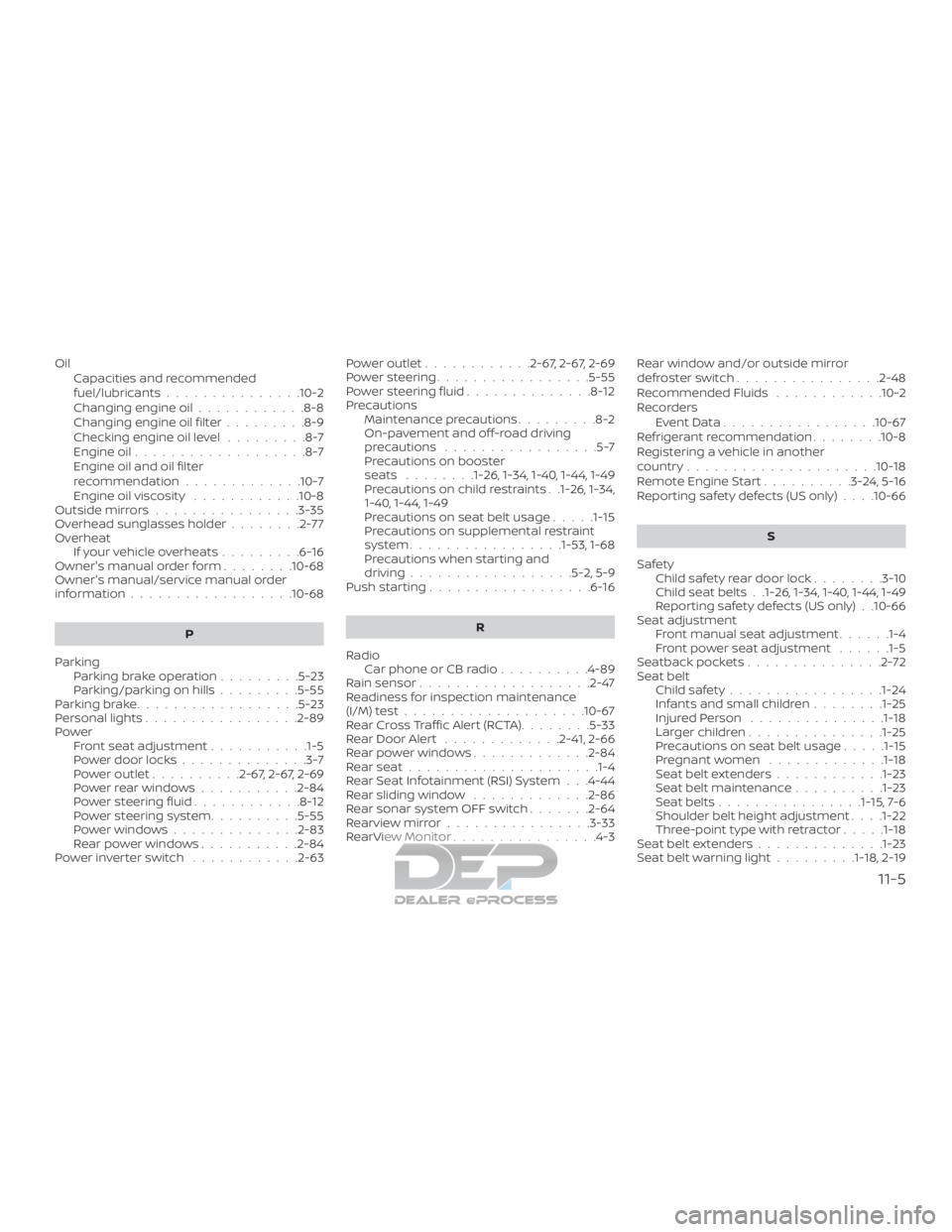
OilCapacities and recommended
fuel/lubricants...............10-2
Changing engine oil ............8-8
Changing engine oil filter .........8-9
Checking engine oil level .........8-7
Engine oil ...................8-7
Engine oil and oil filter
recommendation .............10-7
Engine oil viscosity ............10-8
Outsidemirrors................3-35
Overhead sunglasses holder ........2-77
Overheat Ifyourvehicleoverheats.........6-16
Owner's manual order form ........10-68
Owner's manual/service manual order
information..................10-68
P
Parking Parking brake operation .........5-23
Parking/parkingonhills.........5-55
Parkingbrake..................5-23
Personal lights .................2-89
Power Front seat adjustment ...........1-5
Power door locks ..............3-7
Poweroutlet..........2-67,2-67,2-69
Powerrearwindows...........2-84
Powersteeringfluid............8-12
Power steering system ..........5-55
Powerwindows..............2-83
Rearpowerwindows...........2-84
Powerinverterswitch ............2-63 Poweroutlet............2-67,2-67,2-69
Powersteering.................5-55
Powersteeringfluid..............8-12
Precautions
Maintenance precautions .........8-2
On-pavement and off-road driving
precautions .................5-7
Precautions on booster
seats ........1-26, 1-34, 1-40, 1-44, 1-49
Precautions on child restraints . .1-26, 1-34,
1-40, 1-44, 1-49
Precautions on seat belt usage .....1-15
Precautions on supplemental restraint
system .................1-53, 1-68
Precautions when starting and
driving..................5-2,5-9
Push starting ..................6-16
R
Radio Car phone or CB radio ..........4-89
Rain sensor ...................2-47
Readiness for inspection maintenance
(I/M) test ....................10-67
RearCrossTrafficAlert(RCTA)........5-33
Rear Door Alert .............2-41,2-66
Rearpowerwindows.............2-84
Rearseat.....................1-4
Rear Seat Infotainment (RSI) System . . .4-44
Rearslidingwindow .............2-86
Rear sonar system OFF switch .......2-64
Rearviewmirror................3-33
RearViewMonitor................4-3 Rear window and/or outside mirror
defrosterswitch................2-48
Recommended Fluids
............10-2
Recorders EventData.................10-67
Refrigerant recommendation ........10-8
Registering a vehicle in another
country .....................10-18
Remote Engine Start ..........3-24,5-16
Reporting safety defects (US only) . . . .10-66
S
Safety Child safety rear door lock ........3-10
Child seat belts . .1-26, 1-34, 1-40, 1-44, 1-49
Reporting safety defects (US only) . .10-66
Seat adjustment Front manual seat adjustment ......1-4
Front power seat adjustment ......1-5
Seatback pockets ...............2-72
Seat belt Childsafety.................1-24
Infants and small children ........1-25
InjuredPerson .............. .1-18
L a r
gerchildren.............. .1-25
Precautionsonseatbeltusage.....1-15
Pregnant women .............1-18
Seat belt extenders ............1-23
Seat belt maintenance ..........1-23
Seatbelts................1-15, 7-6
Shoulder belt height adjustment . . . .1-22
Three-pointtypewithretractor.....1-18
Seat belt extenders ..............1-23
Seatbeltwarninglight.........1-18, 2-19
11-5
Page 623 of 682
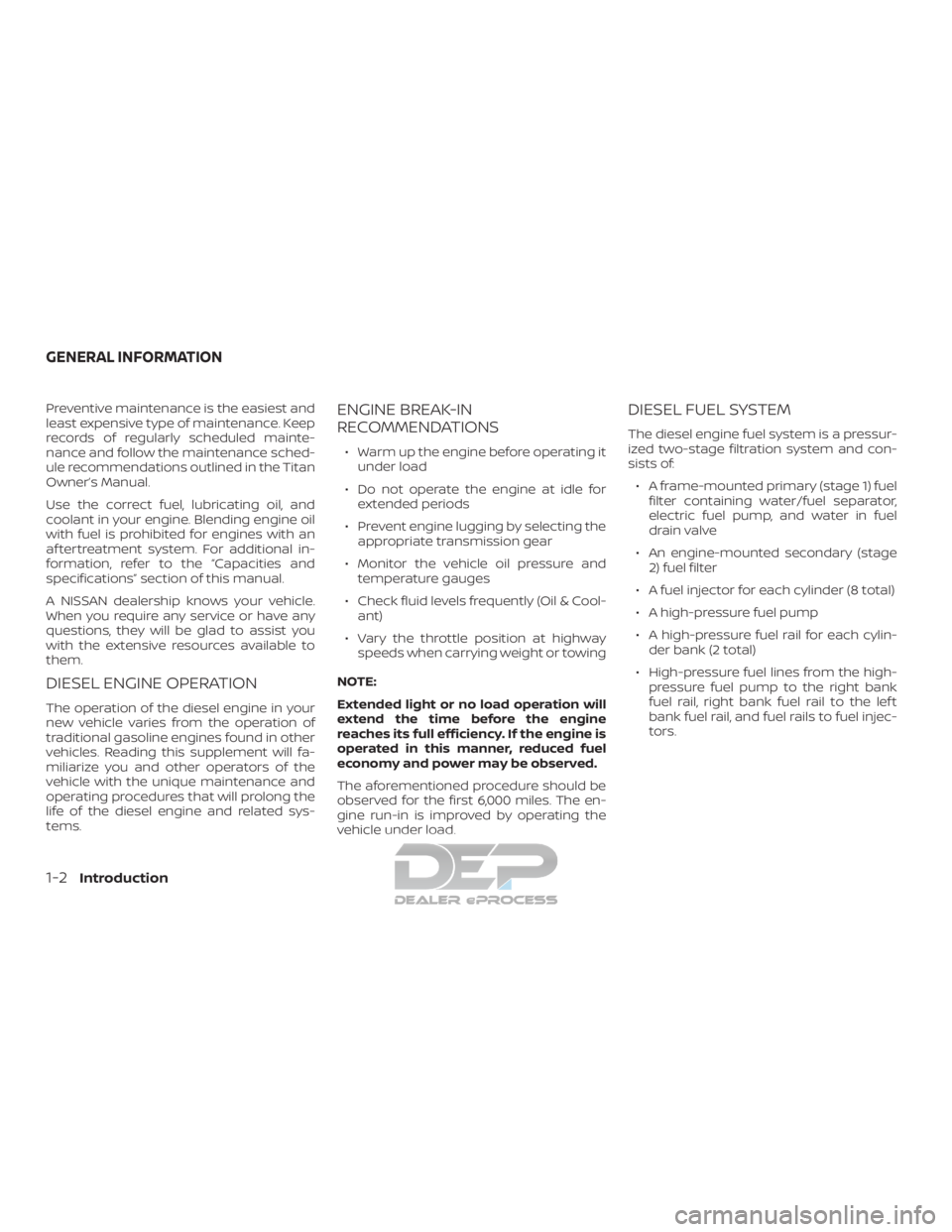
Preventive maintenance is the easiest and
least expensive type of maintenance. Keep
records of regularly scheduled mainte-
nance and follow the maintenance sched-
ule recommendations outlined in the Titan
Owner’s Manual.
Use the correct fuel, lubricating oil, and
coolant in your engine. Blending engine oil
with fuel is prohibited for engines with an
af tertreatment system. For additional in-
formation, refer to the “Capacities and
specifications” section of this manual.
A NISSAN dealership knows your vehicle.
When you require any service or have any
questions, they will be glad to assist you
with the extensive resources available to
them.
DIESEL ENGINE OPERATION
The operation of the diesel engine in your
new vehicle varies from the operation of
traditional gasoline engines found in other
vehicles. Reading this supplement will fa-
miliarize you and other operators of the
vehicle with the unique maintenance and
operating procedures that will prolong the
life of the diesel engine and related sys-
tems.
ENGINE BREAK-IN
RECOMMENDATIONS
∙ Warm up the engine before operating itunder load
∙ Do not operate the engine at idle for extended periods
∙ Prevent engine lugging by selecting the appropriate transmission gear
∙ Monitor the vehicle oil pressure and temperature gauges
∙ Check fluid levels frequently (Oil & Cool- ant)
∙ Vary the throttle position at highway speeds when carrying weight or towing
NOTE:
Extended light or no load operation will
extend the time before the engine
reaches its full efficiency. If the engine is
operated in this manner, reduced fuel
economy and power may be observed.
The aforementioned procedure should be
observed for the first 6,000 miles. The en-
gine run-in is improved by operating the
vehicle under load.
DIESEL FUEL SYSTEM
The diesel engine fuel system is a pressur-
ized two-stage filtration system and con-
sists of: ∙ A frame-mounted primary (stage 1) fuel filter containing water/fuel separator,
electric fuel pump, and water in fuel
drain valve
∙ An engine-mounted secondary (stage 2) fuel filter
∙ A fuel injector for each cylinder (8 total)
∙ A high-pressure fuel pump
∙ A high-pressure fuel rail for each cylin- der bank (2 total)
∙ High-pressure fuel lines from the high- pressure fuel pump to the right bank
fuel rail, right bank fuel rail to the lef t
bank fuel rail, and fuel rails to fuel injec-
tors.
GENERAL INFORMATION
1-2Introduction
Page 624 of 682
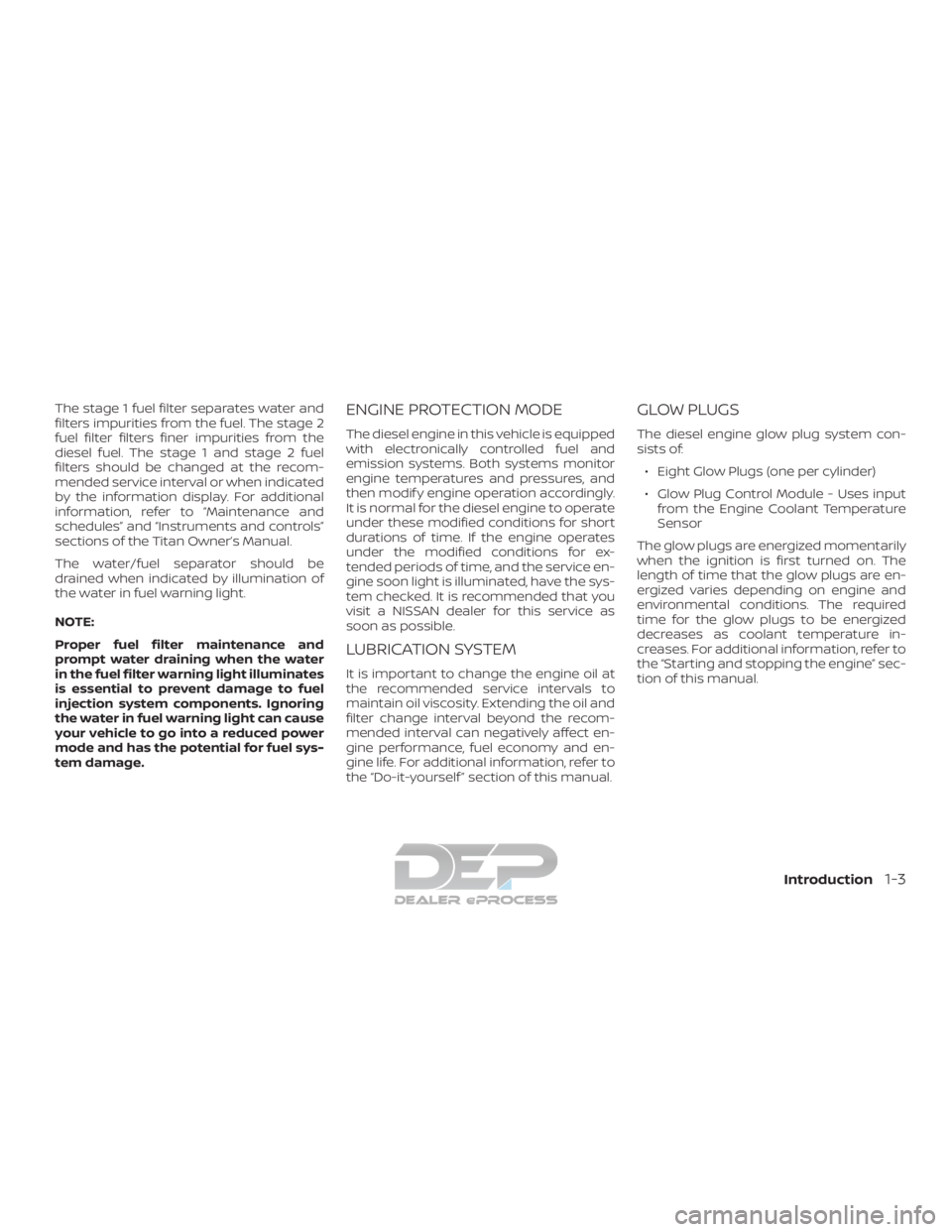
The stage 1 fuel filter separates water and
filters impurities from the fuel. The stage 2
fuel filter filters finer impurities from the
diesel fuel. The stage 1 and stage 2 fuel
filters should be changed at the recom-
mended service interval or when indicated
by the information display. For additional
information, refer to “Maintenance and
schedules” and “Instruments and controls”
sections of the Titan Owner’s Manual.
The water/fuel separator should be
drained when indicated by illumination of
the water in fuel warning light.
NOTE:
Proper fuel filter maintenance and
prompt water draining when the water
in the fuel filter warning light illuminates
is essential to prevent damage to fuel
injection system components. Ignoring
the water in fuel warning light can cause
your vehicle to go into a reduced power
mode and has the potential for fuel sys-
tem damage.ENGINE PROTECTION MODE
The diesel engine in this vehicle is equipped
with electronically controlled fuel and
emission systems. Both systems monitor
engine temperatures and pressures, and
then modif y engine operation accordingly.
It is normal for the diesel engine to operate
under these modified conditions for short
durations of time. If the engine operates
under the modified conditions for ex-
tended periods of time, and the service en-
gine soon light is illuminated, have the sys-
tem checked. It is recommended that you
visit a NISSAN dealer for this service as
soon as possible.
LUBRICATION SYSTEM
It is important to change the engine oil at
the recommended service intervals to
maintain oil viscosity. Extending the oil and
filter change interval beyond the recom-
mended interval can negatively affect en-
gine performance, fuel economy and en-
gine life. For additional information, refer to
the “Do-it-yourself ” section of this manual.
GLOW PLUGS
The diesel engine glow plug system con-
sists of:∙ Eight Glow Plugs (one per cylinder)
∙ Glow Plug Control Module - Uses input from the Engine Coolant Temperature
Sensor
The glow plugs are energized momentarily
when the ignition is first turned on. The
length of time that the glow plugs are en-
ergized varies depending on engine and
environmental conditions. The required
time for the glow plugs to be energized
decreases as coolant temperature in-
creases. For additional information, refer to
the “Starting and stopping the engine” sec-
tion of this manual.
Introduction1-3
Page 632 of 682
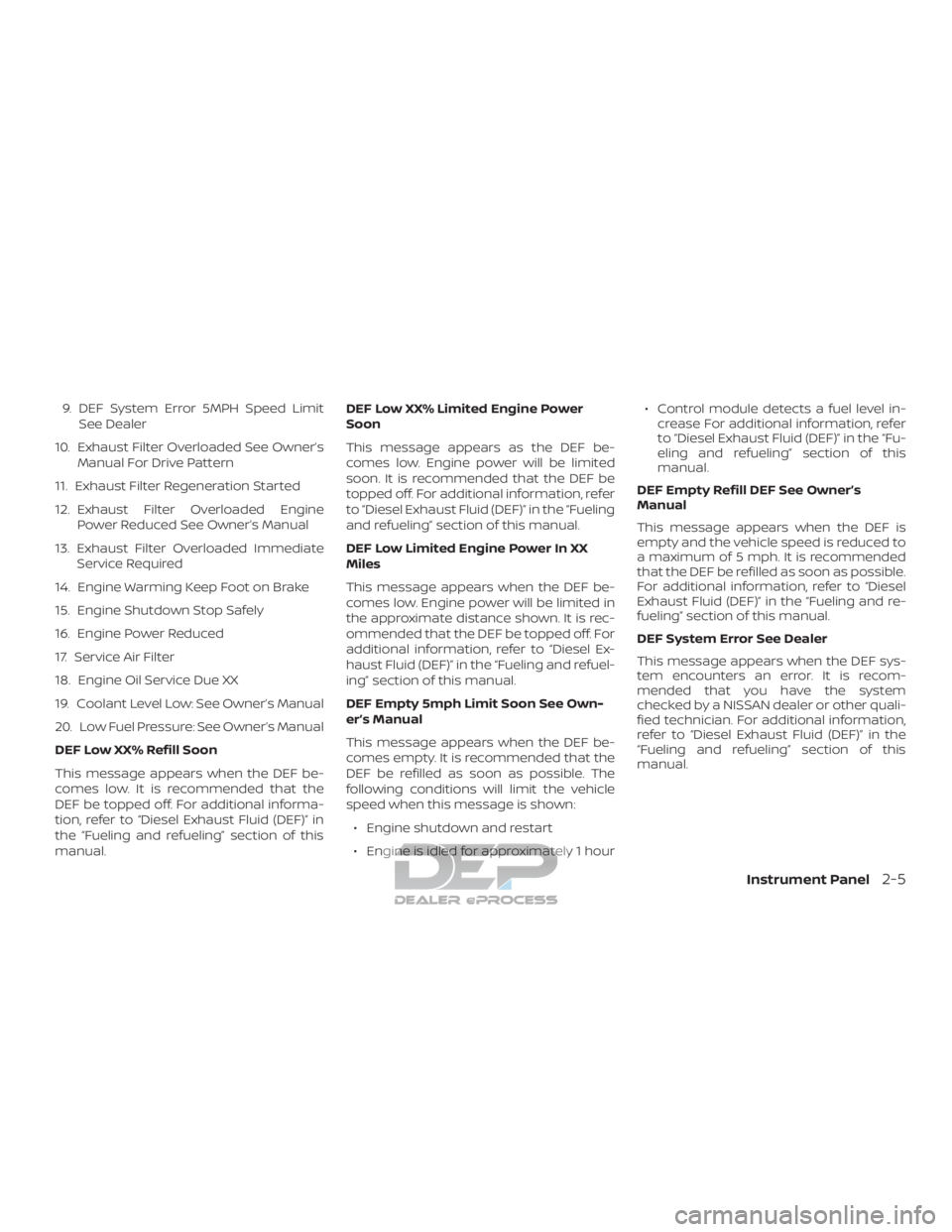
9. DEF System Error 5MPH Speed LimitSee Dealer
10. Exhaust Filter Overloaded See Owner’s Manual For Drive Pattern
11. Exhaust Filter Regeneration Started
12. Exhaust Filter Overloaded Engine Power Reduced See Owner’s Manual
13. Exhaust Filter Overloaded Immediate Service Required
14. Engine Warming Keep Foot on Brake
15. Engine Shutdown Stop Safely
16. Engine Power Reduced
17. Service Air Filter
18. Engine Oil Service Due XX
19. Coolant Level Low: See Owner’s Manual
20. Low Fuel Pressure: See Owner’s Manual
DEF Low XX% Refill Soon
This message appears when the DEF be-
comes low. It is recommended that the
DEF be topped off. For additional informa-
tion, refer to “Diesel Exhaust Fluid (DEF)” in
the “Fueling and refueling” section of this
manual. DEF Low XX% Limited Engine Power
Soon
This message appears as the DEF be-
comes low. Engine power will be limited
soon. It is recommended that the DEF be
topped off. For additional information, refer
to “Diesel Exhaust Fluid (DEF)” in the “Fueling
and refueling” section of this manual.
DEF Low Limited Engine Power In XX
Miles
This message appears when the DEF be-
comes low. Engine power will be limited in
the approximate distance shown. It is rec-
ommended that the DEF be topped off. For
additional information, refer to “Diesel Ex-
haust Fluid (DEF)” in the “Fueling and refuel-
ing” section of this manual.
DEF Empty 5mph Limit Soon See Own-
er’s Manual
This message appears when the DEF be-
comes empty. It is recommended that the
DEF be refilled as soon as possible. The
following conditions will limit the vehicle
speed when this message is shown:
∙ Engine shutdown and restart
∙ Engine is idled for approximately 1 hour ∙ Control module detects a fuel level in-
crease For additional information, refer
to “Diesel Exhaust Fluid (DEF)” in the “Fu-
eling and refueling” section of this
manual.
DEF Empty Refill DEF See Owner’s
Manual
This message appears when the DEF is
empty and the vehicle speed is reduced to
a maximum of 5 mph. It is recommended
that the DEF be refilled as soon as possible.
For additional information, refer to “Diesel
Exhaust Fluid (DEF)” in the “Fueling and re-
fueling” section of this manual.
DEF System Error See Dealer
This message appears when the DEF sys-
tem encounters an error. It is recom-
mended that you have the system
checked by a NISSAN dealer or other quali-
fied technician. For additional information,
refer to “Diesel Exhaust Fluid (DEF)” in the
“Fueling and refueling” section of this
manual.
Instrument Panel2-5